Arctic Photography Tours: A Summer Adventure in Svalbard

The Arctic has always had a special place in my heart with pristine landscapes, elusive wildlife, and invigorating solitude and going on our Arctic photography tours is one of life’s amazing pleasures.
I am no stranger to Svalbard, having been in March 2019 for a land-based expedition, and in April 2024 for a cruise around the Archipelago with Norwegian travel company Arctic Wildlife Tours as they are the best also for Arctic photography tours!
Both times I chose to come in the winter, as it is my favourite season from a wildlife photography perspective, so when the team at Arctic Wildlife Tours offered me to join their summer voyage, I did not know what to expect!
Changing Regulations in Svalbard
The regulations on Svalbard have gone through a seismic shift at the start of 2025 with new rules in place making close wildlife encounters much more difficult.
Not wanting to get into a debate on the pros and cons of the new rules, but they seem to be a blanket “one size fits all” hard line despite a completely clean track record of wildlife welfare from the more reputable small-scale expedition companies.
This is important context to both the season choice, and the new star of the show, M/S Kvitungen, a snow crab fishing vessel chartered for the 2025 season.
Why Arctic Expeditions Are Changing
Prior to the new regulations, boats could sail around Svalbard on the lookout for wildlife and, whenever possible, launch smaller boats to get up close for great photographic opportunities.

With the introduction of the new rules, from March 1st to June 30th a minimum distance of 500 meters from polar bears is mandated. This distance drops to 300 meters the rest of the year.
To experience polar bears up close, encounters must take place outside of the regulation framework up in international waters where, in the summer, the sea ice retreats and with it, a large population of polar bears.
There they can still hunt seals or scavenge on whale or seal carcasses, providing a healthy food source ahead of the harsh Arctic winter.
Having a boat with the ability to go deep into the pack ice without risking getting stuck is critical to successful encounters.
Arctic Wildlife Tour’s M/S Kvitungen is a powerful ship with a high ice class, allowing it to comfortably navigate in what is a deadly maze of ice for most of the other ships in her category.
Now as you have this background, here are the highlights of my summer 2025 trip to Svalbard and Arctic pack ice.
Phase 1: Longyearbyen
My two main worries with Arctic wildlife cruises are 1) missing a connection and arriving after the ship has departed 2) my luggage missing the connection and arriving after the ship has departed!
For these reasons, I often get there at least three days ahead of departure to allow a buffer for any calamity. This gives me ample time to explore the local area and search for wildlife.
A “polar bear safe” zone covers most of Longyearbyen and is home to most of the iconic wildlife of the Archipelago.
In the space of three days, I bumped into five reindeer (including one by the main church), more Svalbard rock ptarmigans and purple sandpipers than I can count, three arctic foxes and a family of red throated divers.
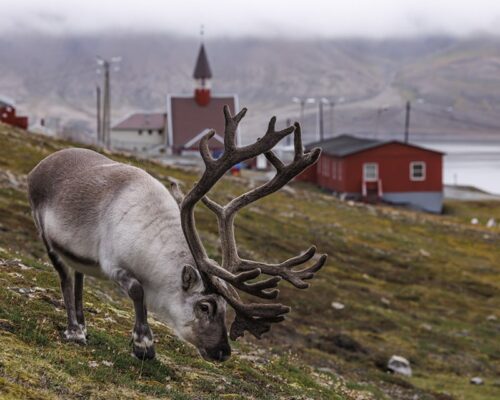
The wildlife on Svalbard is not afraid of human presence and will get close as long as you abide by a few principles:
1. Don’t chase, look at the direction of travel, position yourself ahead, sit and wait. Let the wildlife approach you
2. No sudden movement, loud noise or erratic behaviour. Be mindful of Velcro, straps, clips, shutter sounds etc
3. Do not obstruct obvious exits/escape routes. Stand out of the way and chances are they will walk right past you
4. Take your time when leaving. Your exit should be as slow and steady as your approach and the wildlife might not even notice you!
Spotting wildlife in Longyearbyen can be luck of the draw, and if you are not finding what you are after there are plenty of reputable companies offering wildlife excursions in the surrounding wilderness.
Phase 2: Boarding and Heading North
We boarded the ship at 4pm from the Longyearbyen pier. After a quick briefing on the general plan for the week, we all got to fill up the nooks and crannies of the ship with our camera gear.
Misplacing lenses, batteries, camera bodies and other equipment quickly became a recurring theme for this trip!
With all the back and forth between deck and galley via the mess and cabins, the step count was just about enough to balance the delicious food cooked daily.
After a long night in moderate swell, we reached our first stop, Bjørnfjorden, a beautiful glacier front with deep blue ice and very relaxed walrus.
We then carried on North until we spotted our very first bear at 79º24N 10º23 E, facing off a small colony of Walruses.
As this was still pretty much inside the Svalbard waters, we could only observe the scene from a distance.
The rest of the day was spent at sea, making our way towards Lågøya, a Walrus haul-out spot which we would reach the next day at 3am. 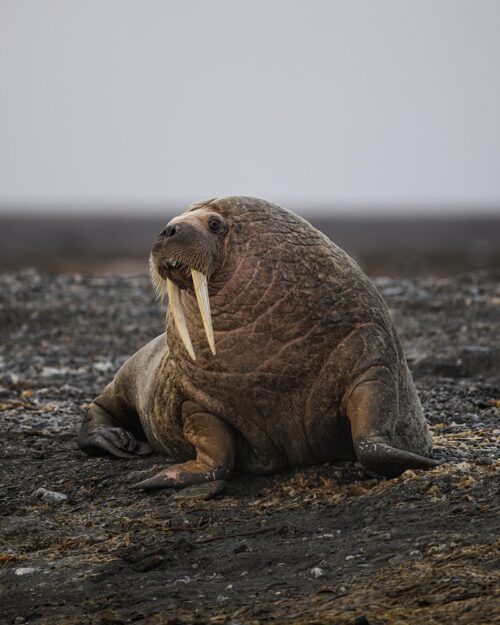
This was our first Zodiac outing, and we were greeted with great light but little Walrus activity!
It was then time to sail past the Seven Islands, and head to the place we were all longing to see, the pack ice.
Phase 3: A World of Ice and Polar Bears
Twelve hours after leaving the Seven Islands behind, the first rumbles of crushed ice were heard.
For the next three hours, we made our way deeper into the ice, on the lookout for wildlife.
Shortly before 3am, we spotted our first bears, not one or two, but between seven and nine (depending on who you ask!). I had seen polar bears in the past, but never up close. I was not ready for what came next.
For the next ten hours, the more curious of the bears came close to the ship to have a good look, whilst the rest of the group were just playing in the distance.
This is the kind of close polar bear encounter that makes Arctic expeditions so unique
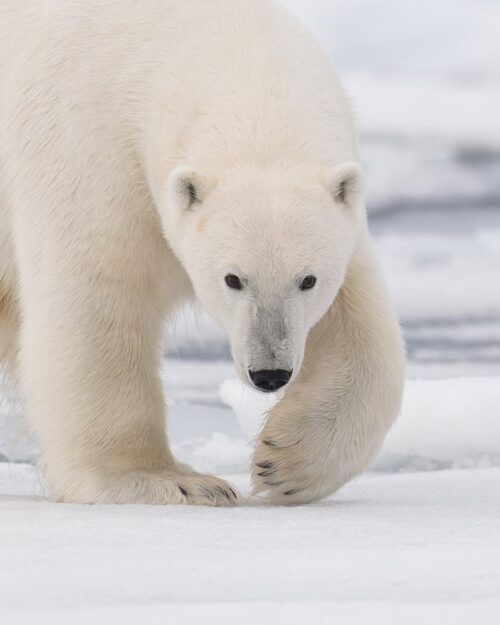
We were treated to incredible close ups
And larger compositions that I would never have dreamt of capturing
It was truly amazing to see these incredible predators behave like a pack of very sociable Labradors. They must have had a decent meal not so long ago!
As the day progressed the bears slowly drifted away so we decided to leave our spot and carry on further up North.
We came upon another group of bears just after midnight, giving us our only opportunity of golden hour photography.
The light was short lived and quickly gave way to dense sea fog.
As it cleared, I noticed a strange looking clump of fur in the distance through my binoculars and decided to investigate it using my drone. I couldn’t believe the image on the screen.
A beautiful bear asleep next to a magnificent piece of blue ice and right at the intersection of two leading lines.
This ended up being one of my favourite pictures of the trip.
 The whole time I was monitoring that the bear could not hear the drone. I took the shot and slowly retreated, leaving behind a happily sleeping bear.
The whole time I was monitoring that the bear could not hear the drone. I took the shot and slowly retreated, leaving behind a happily sleeping bear.
Around lunch time we spotted one of the young females that came close to the boat the previous day on an ice floe in open water. The perfect opportunity for a Zodiac cruise!
We launched the two small boats and weaved our way towards the bear.
I am not one for including man-made objects in my wildlife images, but I couldn’t resist taking this rather unique photo of our ship! (PHOTO HERE -17)
Not to overstay our welcome, we soon made our way back to the ship and carried on our journey (you guessed it) North!
On the way we spotted a rather large female on a beautiful piece of blue ice.
Little did we know that she would be curious enough to come all the way to the ship and even nap a while just next to us.
(PHOTO HERE -23)
She was our last bear sighting until the next day late afternoon, when we came across a huge male with a bloodied face sitting on a piece of blue ice.
This one had no interest in getting close, so we quickly sailed away. It was now time to start our journey back South, but that wasn’t without spotting another bear in a beautiful fog bow. (PHOTO HERE -28)
Phase 4: The Journey Back
Despite spending days in the ice, it felt like we had just been in this magical place for a couple of hours.
Sadly, it was time to make our way down in a race against time to get back to Longyearbyen.
We pushed all the way to 83.2º North, making us the furthest North ship at the time!
Reaching Svalbard took an entire day and night of sailing, the perfect opportunity to photograph the ballet of fulmars, and the sun setting behind a thick layer of sea mist
Around 3am the next day, we reached the glacier front of Liefdefjorden, where amazing light and textures were awaiting us.
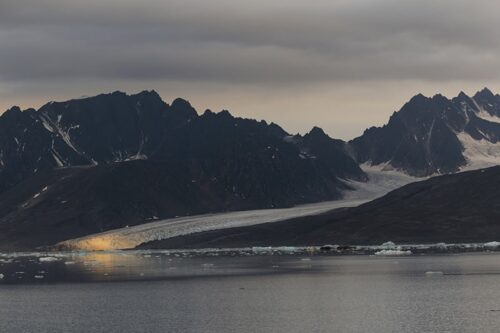
We carried on our journey South, hugging the coast and getting into several fjords throughout the night
The next morning, we spotted a mother bear and two cubs strolling on the shore at the foot of a dramatic mountain.
A perfect way to start a day rich in wildlife encounters with plenty of Arctic fox activity later.
We Zodiac cruised at the bottom of kittiwake cliffs in Kongsfjorden and witnessed beautiful interaction between two white foxes, a blue fox and an angry Skua protecting its nearby nest.
This was our last wildlife encounter before reaching Longyearbyen the following day.
Conclusion: Why Arctic Wildlife Cruises Are Unforgettable
What a shock to the system this was. For my winter loving self, this turned out to be one of my favourite trips of all time.
Sure, the light, landscapes and ice around Svalbard in the winter are on a whole other level of magic, but nothing prepared me for the once-in-a-lifetime polar bear encounters I was fortunate enough to experience.
If bears are not a top priority for your own wildlife photography, I would 100% recommend an early season cruise; but if you want to experience bears up close, heading into the thick pack ice mid-summer is the way to do it.
Joining Arctic Photography Tours on the M/S Kvitungen gave me a new appreciation for the power of these Arctic expeditions.
This was more than just a trip — it was a reminder of how fragile, vast, and awe-inspiring the Arctic truly is.
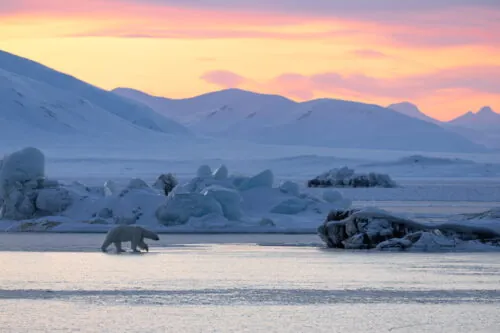
About the Author
I am a London-based wildlife photographer with a passion for cold and wild spaces.
I strive to represent my subjects the way I saw them in real life and to only capture photographs in an ethical way. You can follow my work on Instagram.com/fbimages